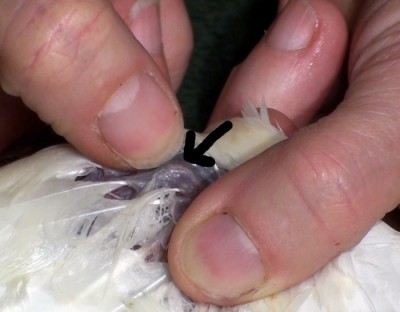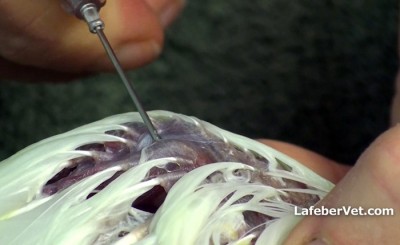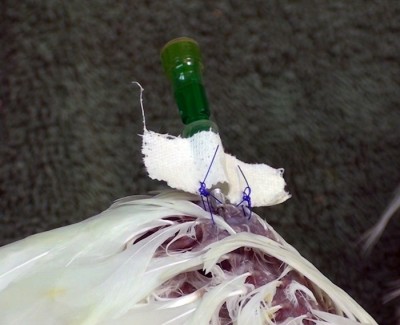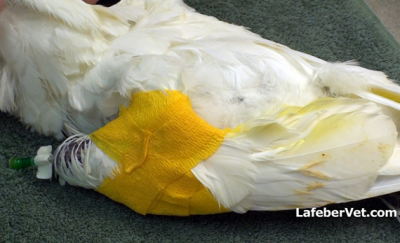Introduction
Fluid therapy is indicated in critical patients including exotic animals. Vascular access can be extremely difficult or even impossible during shock, making intraosseous or IO catheterization necessary. Fortunately fluids and medications given through IO catheters are immediately taken up into the vasculature. The distal ulna is the site of choice for IO catheter placement in birds (Fig 1).
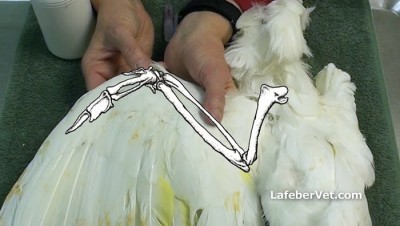
Figure 1. The distal ulna is the site of choice for intraosseous catheter placement in birds. Click image to enlarge.
In some patients, such as those with respiratory distress, abdominal distension, or extreme debilitation, subcutaneous fluid therapy may be the safest route initially.
Video
Video produced by Dr. M. Scott Echols and narrated by Dr. Susan Orosz.
Equipment needed
- Spinal needle or hypodermic needle of appropriate size
- Local anesthetic
- 3-6 ml syringe partially filled with heparinized saline
- White porous tape
- Suture
- Needle holders
- Bandage material
- Catheter cap or infusion plug
- Sterile gloves
- Fluid or syringe pump
Potential complication
The patient can drown if the catheter is placed in a long bone with an air sac diverticulum like the humerus (Fig 2).
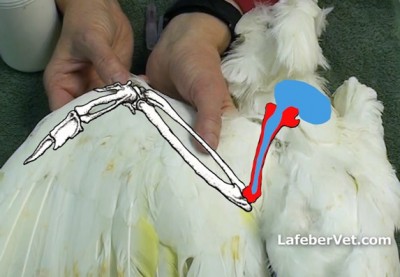
Figure 2. The patient can drown if the catheter is placed in a long bone with an air sac diverticulum like the humerus. Click image to enlarge.
Step-by-step instructions
- Intraosseous catheter placement is considered painful so provide pre-emptive analgesia.
- Flex the carpus and identify the needle insertion site on the dorsal surface of the ulna just distal to the condyle. The insertion site may be felt as a plateau-like depression just ventral to the dorsal condyle (Fig 3).
- Infuse local anesthetic to anesthetize the periosteum and overlying structures. Be sure you are confident about the insertion site beforehand since the bony depression will now be obliterated by the infusion of a local anesthetic.
- Perform an aseptic surgical preparation of the skin using antiseptic solution and alcohol or sterile saline.
- Use the non-dominant hand to grasp the limb, place one finger on the long axis of the bone.
- Grasp the needle securely between the thumb and first finger of your dominant hand.
- Insert the needle in the mid portion of the condyle and in the same plane as the curve of the bone (Fig 4). The curve of the ulna varies among species so palpation of the bone will assist in placing the needle correctly.
- Seat the tip of the needle into the periosteum. Then rotate the needle to advance the needle into the medullary cavity of the bone. A gentle “pop” may be felt as the needle passes through the cortex and into the medullary cavity.
- Flush the catheter immediately with a small volume of heparinized saline. If a hypodermic needle is used, bone may plug the catheter. If the needle is plugged, just remove and place a new needle in the same hole. It often helps to use the next size up (For instance, if a 22-gauge needle becomes plugged then next place a 20-ga needle).
- Secure the catheter using butterfly tape and stay sutures (Fig 5).
- Lightly bandage the limb, using a figure-of-eight wrap to immobilize the wing (Fig 6).
Like intravenous catheters, IO catheters may be left in place for up to 72 hours. Check catheter placement regularly.
Further reading
Antinoff N. Catheters in birds: When, where, and how? Proc Annu Conf Assoc Avian Veterinarians; 2009.
Bowles H, Lichtenberger M, Lennox A. Emergency and critical care of pet birds. Vet Clin North America Exotic Animal Practice 10(2):355, 2007.
Pollock C. Intraosseous catheter placement in the bird. December 9, 2010. LafeberVet Web site. Available at https://lafeber.com/vet/intraosseous-catheter-placement-in-the-bird/
